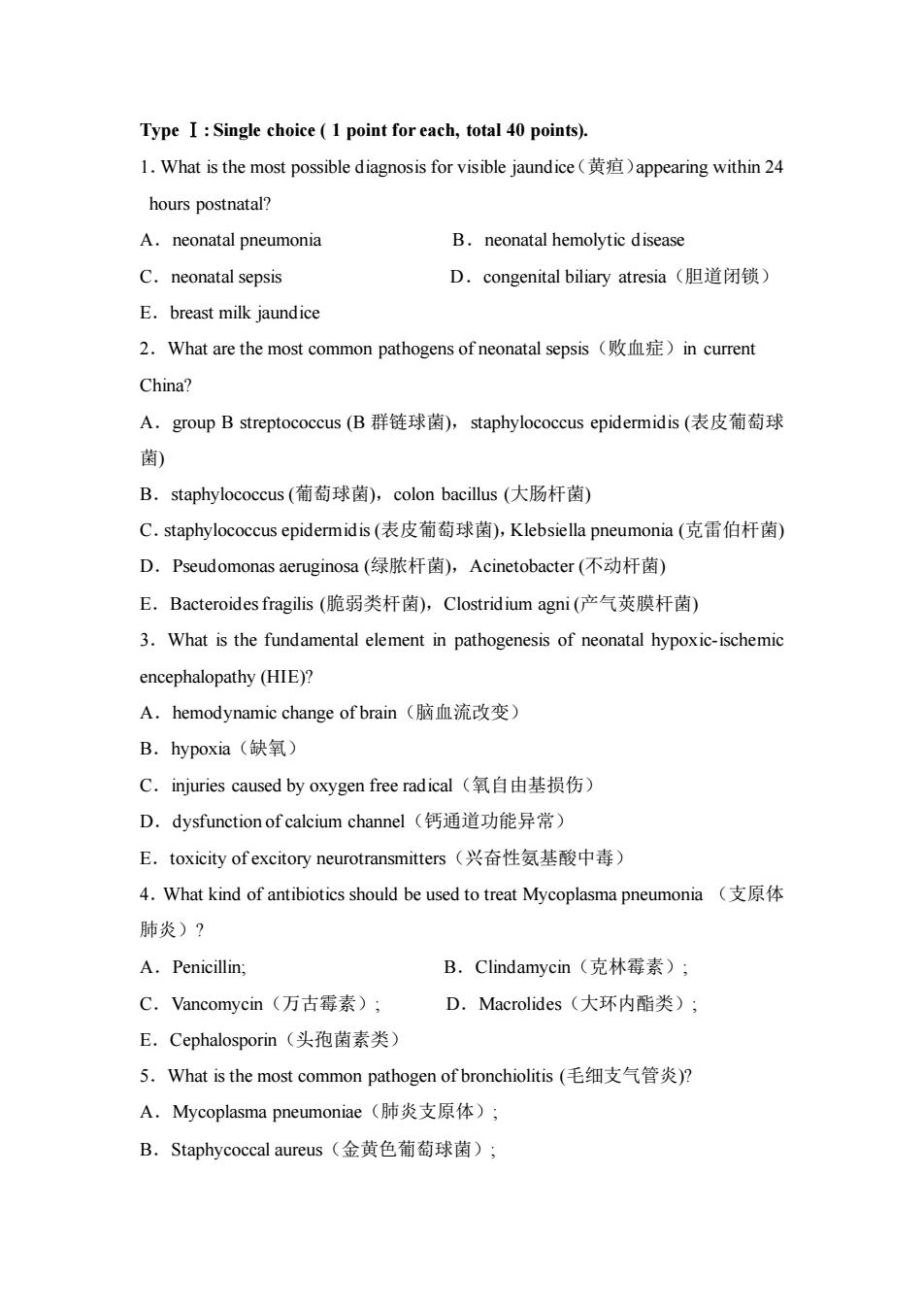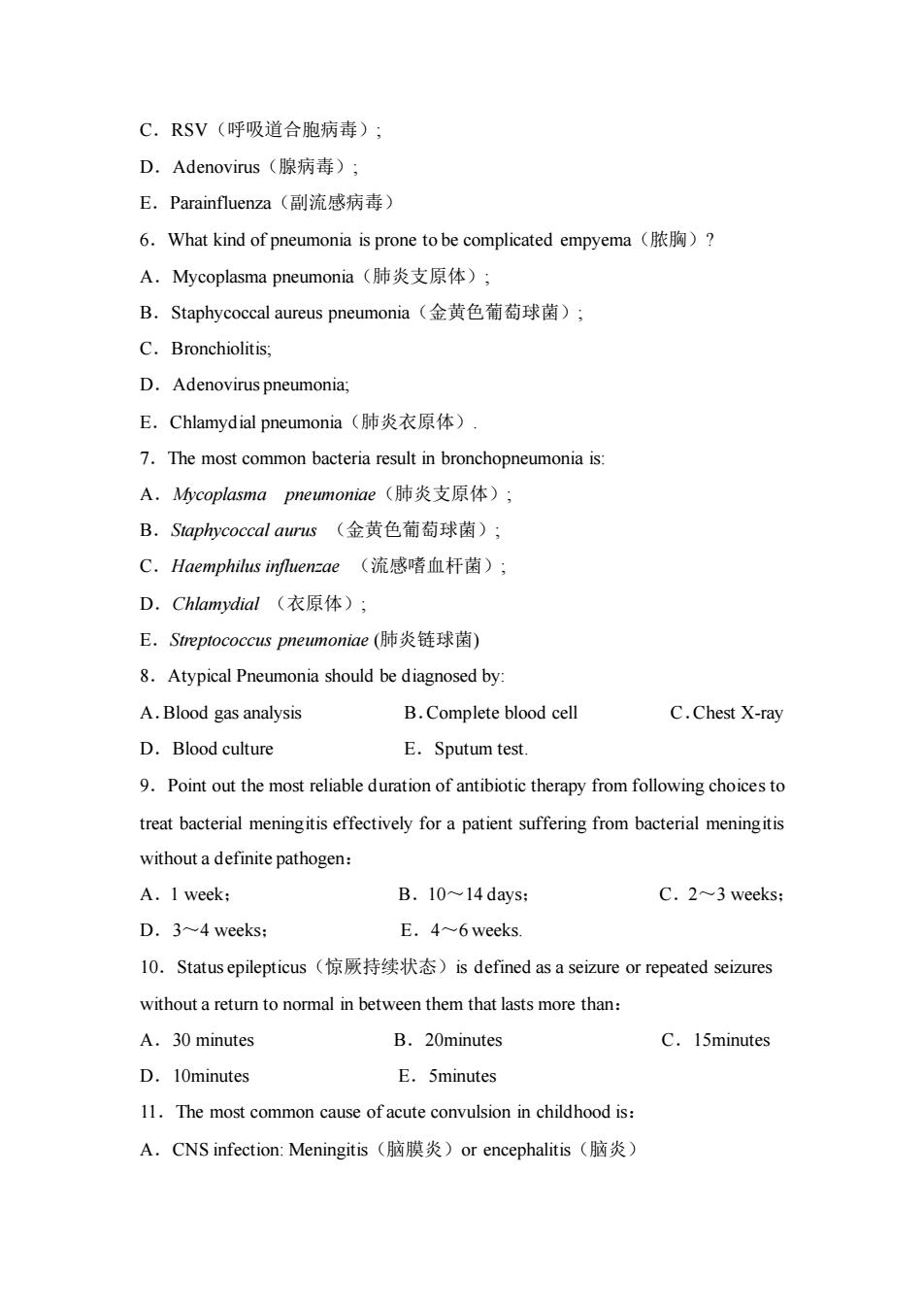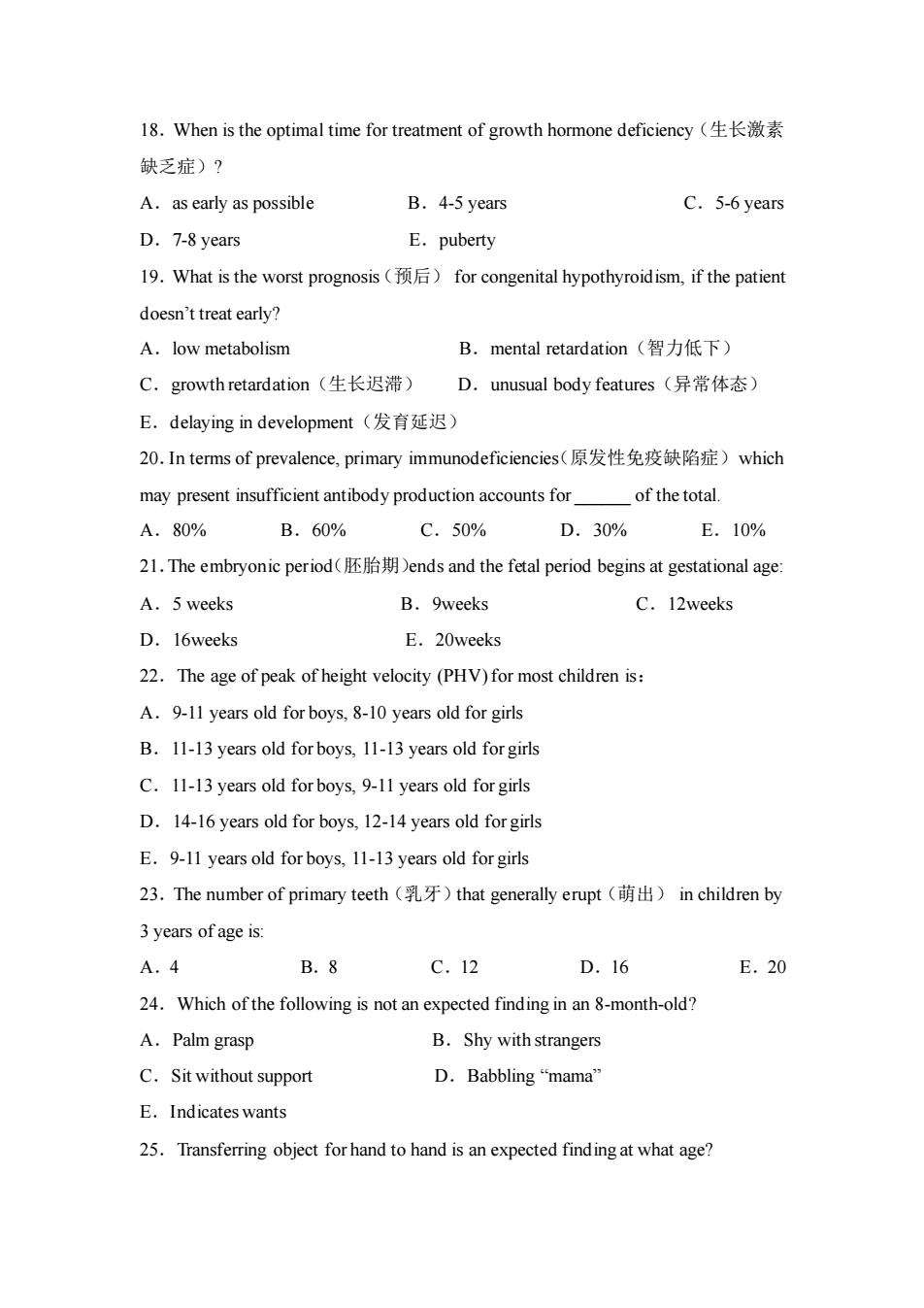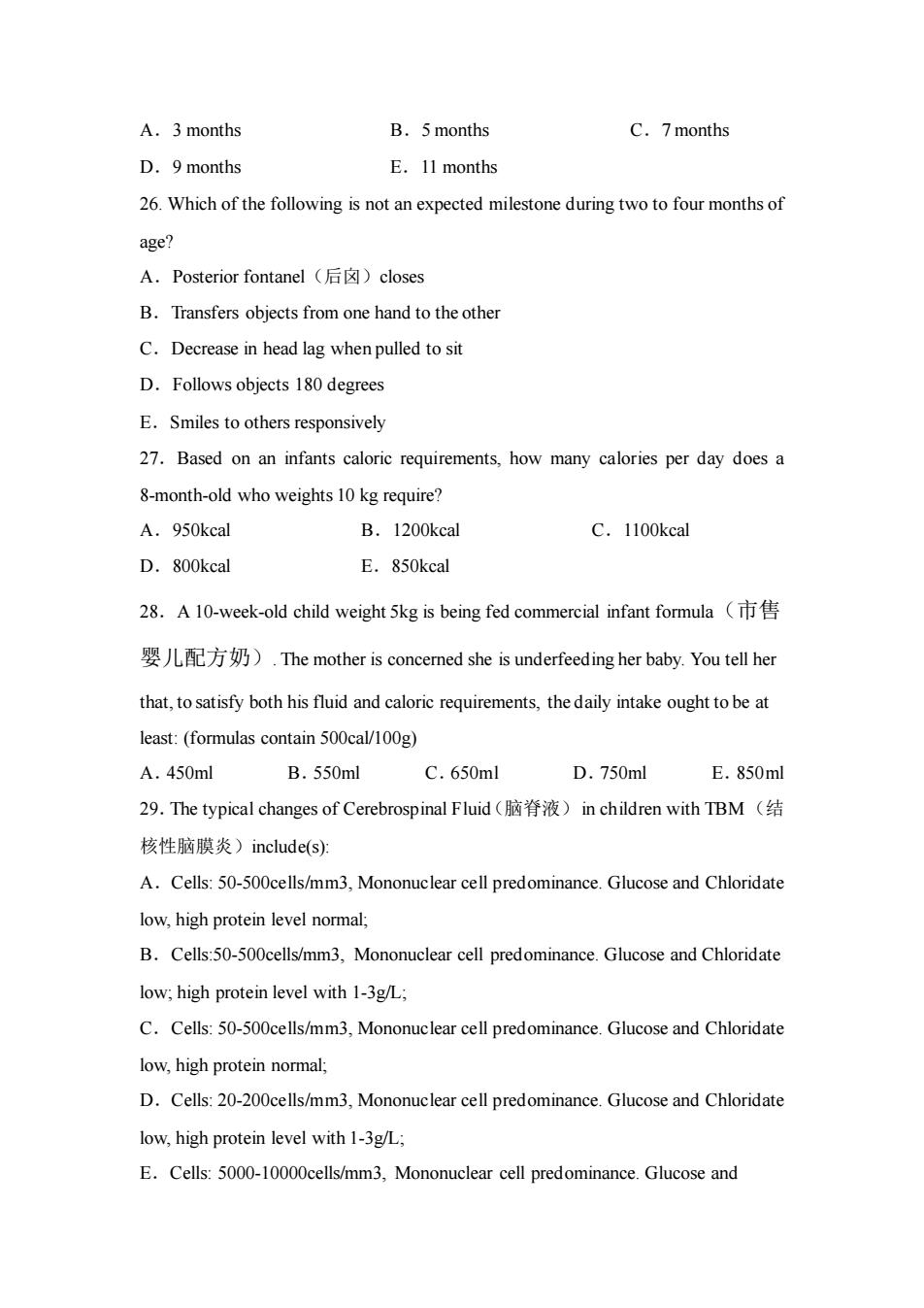
Type I : Single choice (1 point for each, total 40 points)1. What is the most possible diagnosis for visible jaundice(黄疽)appearing within 24hours postnatal?A. neonatal pneumoniaB.neonatal hemolytic diseaseC. neonatal sepsisD.congenital biliary atresia(胆道闭锁)E. breast milk jaundice2. What are thof neonatal sepsis(败血症)in currentChina?A:groupBstreptococcus(B群链球菌),staphylococcus epidermidis(表皮葡萄球菌)B.staphylococcus(葡萄球菌),colon bacillus (大肠杆菌)C.staphylococcusepidermidis(表皮葡萄球菌),Klebsiellapneumonia(克雷伯杆菌)D.Pseudomonas aeruginosa(绿脓杆菌),Acinetobacter(不动杆菌)E.Bacteroidesfragilis(脆弱类杆菌),Clostridium agni(产气荚膜杆菌)3. What is the fundamental element in pathogenesis of neonatal hypoxic-ischemicencephalopathy (HIE)?A.hemodynamic change of brain (脑血流改变)B.hypoxia(缺氧)C.injuriescausedbyoxygenfreeradical(氧自由基损伤)D.dysfunctionofcalcium channel(钙通道功能异常)E.toxicity ofexcitornsmitters(兴奋性氨基酸中毒)4.What kind of antibiotics should be used to treat Mycoplasma pneumonia (支原体肺炎)?A. Penicillin,B.Clindamycin(克林霉素);C.Vancomycin(万古霉素);D.Macrolides(大环内酯类);E.Cephalosporin(头孢菌素类)5.What is the most common pathogen of bronchiolitis(毛细支气管炎)?A.Mycoplasma pneumoniae(肺炎支原体);B.Staphycoccal aureus(金黄色葡萄球菌)
Type Ⅰ: Single choice ( 1 point for each, total 40 points). 1.What is the most possible diagnosis for visible jaundice(黄疸)appearing within 24 hours postnatal? A.neonatal pneumonia B.neonatal hemolytic disease C.neonatal sepsis D.congenital biliary atresia(胆道闭锁) E.breast milk jaundice 2.What are the most common pathogens of neonatal sepsis(败血症)in current China? A.group B streptococcus (B 群链球菌),staphylococcus epidermidis (表皮葡萄球 菌) B.staphylococcus (葡萄球菌),colon bacillus (大肠杆菌) C.staphylococcus epidermidis (表皮葡萄球菌),Klebsiella pneumonia (克雷伯杆菌) D.Pseudomonas aeruginosa (绿脓杆菌),Acinetobacter (不动杆菌) E.Bacteroides fragilis (脆弱类杆菌),Clostridium agni (产气莢膜杆菌) 3.What is the fundamental element in pathogenesis of neonatal hypoxic-ischemic encephalopathy (HIE)? A.hemodynamic change of brain(脑血流改变) B.hypoxia(缺氧) C.injuries caused by oxygen free radical(氧自由基损伤) D.dysfunction of calcium channel(钙通道功能异常) E.toxicity of excitory neurotransmitters(兴奋性氨基酸中毒) 4.What kind of antibiotics should be used to treat Mycoplasma pneumonia (支原体 肺炎)? A.Penicillin; B.Clindamycin(克林霉素); C.Vancomycin(万古霉素); D.Macrolides(大环内酯类); E.Cephalosporin(头孢菌素类) 5.What is the most common pathogen of bronchiolitis (毛细支气管炎)? A.Mycoplasma pneumoniae(肺炎支原体); B.Staphycoccal aureus(金黄色葡萄球菌);

C.RSV(呼吸道合胞病毒)D.Adenovirus(腺病毒);E.Parainfluenza(副流感病毒)6. What kind of pneumonia is prone to be complicated empyema (脓胸)?A.Mycoplasmapneumonia(肺炎支原体);B.Staphycoccal aureus pneumonia(金黄色葡萄球菌)C. Bronchiolitis;D. Adenovirus pneumonia;E.Chlamydial pneumonia(肺炎衣原体)7. The most common bacteria result in bronchopneumonia is:A.Mycoplasmapneumoniae(肺炎支原体);B.Staphycoccalaurus(金黄色葡萄球菌);C.Haemphilus influenzae(流感嗜血杆菌);D.Chlamydial(衣原体)E.Streptococcus pneumoniae(肺炎链球菌)8. Atypical Pneumonia should be diagnosed byA. Blood gas analysisB.Complete blood cellC.Chest X-rayD. Blood cultureE. Sputum test9. Point out the most reliable duration of antibiotic therapy from following choices tctreat bacterial meningitis effectively for a patient suffering from bacterial meningitiswithout a definite pathogen:B. 10~14 days;C. 2~3 weeks;A. I week;D. 3~4 weeks;E. 4~6weeks.10. Status epilepticus (惊厥持续状态) is defined as a seizure or repeated seizureswithout a return to normal in betweecenthemththatlastsmorethan:A.30 minutesB.20minutesC. 15minutesD. 10minutesE.5minutes11. The most common cause of acute convulsion in childhood is:A.CNS infection:Meningitis (脑膜炎)or encephalitis (脑炎)
C.RSV(呼吸道合胞病毒); D.Adenovirus(腺病毒); E.Parainfluenza(副流感病毒) 6.What kind of pneumonia is prone to be complicated empyema(脓胸)? A.Mycoplasma pneumonia(肺炎支原体); B.Staphycoccal aureus pneumonia(金黄色葡萄球菌); C.Bronchiolitis; D.Adenovirus pneumonia; E.Chlamydial pneumonia(肺炎衣原体). 7.The most common bacteria result in bronchopneumonia is: A.Mycoplasma pneumoniae(肺炎支原体); B.Staphycoccal aurus (金黄色葡萄球菌); C.Haemphilus influenzae (流感嗜血杆菌); D.Chlamydial (衣原体); E.Streptococcus pneumoniae (肺炎链球菌) 8.Atypical Pneumonia should be diagnosed by: A.Blood gas analysis B.Complete blood cell C.Chest X-ray D.Blood culture E.Sputum test. 9.Point out the most reliable duration of antibiotic therapy from following choices to treat bacterial meningitis effectively for a patient suffering from bacterial meningitis without a definite pathogen: A.1 week; B.10~14 days; C.2~3 weeks; D.3~4 weeks; E.4~6 weeks. 10.Status epilepticus(惊厥持续状态)is defined as a seizure or repeated seizures without a return to normal in between them that lasts more than: A.30 minutes B.20minutes C.15minutes D.10minutes E.5minutes 11.The most common cause of acute convulsion in childhood is: A.CNS infection: Meningitis(脑膜炎)or encephalitis(脑炎)

B.Febrile convulsions(热性惊厥)C. Head traumaD. CNS malformations (畸形)E. Brain tumors12. Which one is the first choice for seizure control:A.Intravenously administered of diazepam (安定B.Rectal administered of Phenobarbital (苯巴比妥)C. Muscle administered of diazepamD. Intravenously administered of PhenobarbitalE. Muscle administered of Phenobarbital13. The normal pattern of hemoglobin in children beyond 2 years old is:A.HbA30%,HbF60-70%,HbA22-3%B. HbA97%, HbF 1%,HbA2 2%HbA20.5%C. HbA 5-10%, HbF 90%,HbA2 5%D. HbA95%, HbF 1%,E. HbA30%,HbF 60%,HbA2 10%14.The most common and important cause for childhoodIDA(缺铁性贫血)isA. Poor iron storesB. OverdevelopC. Poor dietary iron intakeD. Iron lossD. Chronic bleeding15. About iron therapy, which one of the following is rightA. Infusion iron is the first choice when IDA occursB. Oral ferrous salts (亚铁盐) is the best choice formost patients.C. Oral iron should be taken right after the meals.D. Administrating iron with milk together favors the absorption of iron.E. Iron therapy should be stopped when the hemoglobin is above the normal value16.Evidence ofa recent streptococci(链球菌)infection is:A. SRB. C31C. BUNTD. Alb↑E. ASO↑17.Themost commoncongenitalheartdiseaseinchildreniA. ASDB. VSDC. PDAD.TOFE.PS(肺动脉狭窄)
B.Febrile convulsions(热性惊厥) C.Head trauma D.CNS malformations(畸形) E.Brain tumors 12.Which one is the first choice for seizure control: A.Intravenously administered of diazepam(安定) B.Rectal administered of Phenobarbital(苯巴比妥) C.Muscle administered of diazepam D.Intravenously administered of Phenobarbital E.Muscle administered of Phenobarbital 13.The normal pattern of hemoglobin in children beyond 2 years old is: A.HbA 30%, HbF 60-70%, HbA2 2-3% B.HbA 97%, HbF 1%, HbA2 2% C.HbA 5-10%, HbF 90%, HbA2 0.5% D.HbA 95%, HbF 1%, HbA2 5% E.HbA 30%, HbF 60%, HbA2 10% 14.The most common and important cause for childhood IDA (缺铁性贫血)is: A.Poor iron stores B.Overdevelop C.Poor dietary iron intake D.Iron loss D.Chronic bleeding 15.About iron therapy, which one of the following is right: A.Infusion iron is the first choice when IDA occurs. B.Oral ferrous salts(亚铁盐)is the best choice for most patients. C.Oral iron should be taken right after the meals. D.Administrating iron with milk together favors the absorption of iron. E.Iron therapy should be stopped when the hemoglobin is above the normal value. 16.Evidence of a recent streptococci(链球菌) infection is: A.SR↑ B.C3↓ C.BUN↑ D.Alb↑ E.ASO↑ 17.The most common congenital heart disease in children is: A.ASD B.VSD C.PDA D.TOF E.PS(肺动脉狭窄)

18. When is the optimal time for treatment of growth hormone deficiency (生长激素缺乏症)?A. as early as possibleB. 4-5 yearsC. 5-6 yearsD. 7-8 yearsE. puberty19. Whatis the worst prognosis (预后)for congenital hypothyroidism, fthe patientdoesn't treat early?B.mental retardation(智力低下)A.lowmetabolismC. growth retardation (生长迟滞)D.unusual body features (异常体态)E.delaying in development(发育延迟)20.In terms of prevalence,primary immunodeficiencies(原发性免疫缺陷症)whichmaypresent insufficientantibodyproduction accounts forof the totalA. 80%B. 60%C. 50%D. 30%E.10%21. The embryonic period(胚胎期)ends and the fetal period begins at gestational age:C. 12weeksA.5weeksB. 9weeksD. 16weeksE.20weeks22. The age of peak of height velocity (PHV)for most children is:A. 9-11 years old for boys, 8-10 years old for girlsB. 11-13 years old for boys, 11-13 years old for girlsC. 11-13 years old for boys, 9-11 years old for girlsD. 14-16 years old for boys, 12-14 years old for girlsE. 9-11 years old for boys, 11-13 years old for girls23.The number of primaryteeth(乳牙)that generally erupt(萌出)in childrenby3 years of age is:B. 8D. 16E. 20A. 4C. 1224. Which ofthe following is not an expected finding in an 8-month-old?A. Palm graspB. Shy with strangersD. Babbling"'mama"C. Sit without supportE. Indicates wants25. Transferring object for hand to hand is an expected finding at what age?
18.When is the optimal time for treatment of growth hormone deficiency(生长激素 缺乏症)? A.as early as possible B.4-5 years C.5-6 years D.7-8 years E.puberty 19.What is the worst prognosis(预后) for congenital hypothyroidism, if the patient doesn’t treat early? A.low metabolism B.mental retardation(智力低下) C.growth retardation(生长迟滞) D.unusual body features(异常体态) E.delaying in development(发育延迟) 20.In terms of prevalence, primary immunodeficiencies(原发性免疫缺陷症)which may present insufficient antibody production accounts for _ of the total. A.80% B.60% C.50% D.30% E.10% 21.The embryonic period(胚胎期)ends and the fetal period begins at gestational age: A.5 weeks B.9weeks C.12weeks D.16weeks E.20weeks 22.The age of peak of height velocity (PHV) for most children is: A.9-11 years old for boys, 8-10 years old for girls B.11-13 years old for boys, 11-13 years old for girls C.11-13 years old for boys, 9-11 years old for girls D.14-16 years old for boys, 12-14 years old for girls E.9-11 years old for boys, 11-13 years old for girls 23.The number of primary teeth(乳牙)that generally erupt(萌出) in children by 3 years of age is: A.4 B.8 C.12 D.16 E.20 24.Which of the following is not an expected finding in an 8-month-old? A.Palm grasp B.Shy with strangers C.Sit without support D.Babbling “mama” E.Indicates wants 25.Transferring object for hand to hand is an expected finding at what age?

A. 3 monthsB. 5monthsC. 7monthsD. 9monthsE. 11 months26.Which of the following is ncto four months ofage?A.Posterior fontanel (后窗) closesB. Transfers objects from one hand to the otherC. Decrease in head lag when pulled to sitD. Follows objects 180 degreesE. Smiles to others responsively27. Based on an infants caloric requirements, how many calories per day does a8-month-old who weights 10 kg require?A.950kcalB. 1200kcalC. 1100kcalD. 800kcalE.850kcal28. A 10-week-old child weight 5kg is being fed commercial infant formula (市售婴儿配方奶)Themotherisconceed sheisunderfeedingherbabyYoutell herthat,tosatisy both hisfluid and calorc requirements, thedaily intake oughtobe atleast: (formulas contain 500cal/100g)A.450mlB.550mlC.650mlD.750mlE.850ml29.ThetypicalchangesofCerebrospinalFluid(脑脊液)inchildren withTBM(结核性脑膜炎)include(s):A.Cells:50-500cells/mm3,Mononuclear cell predominance.Glucose and Chloridatlow, high protein level normalB. Cells:50-500cells/mm3, Mononuclear cell predominance. Glucose and Chloridatelow, high protein level with 1-3g/lC. Cells: 50-500cells/mm3, Mononuclear cell predominance. Glucose and Chloridatelow, high protein normal,D. Cells: 20-200cells/mm3, Mononuclear cell predominance. Glucose and Chloridatelow,high protein level with1-3g/LE. Cells: 5000-10000cells/mm3, Mononuclear cell predominance. Glucose and
A.3 months B.5 months C.7 months D.9 months E.11 months 26. Which of the following is not an expected milestone during two to four months of age? A.Posterior fontanel(后囟)closes B.Transfers objects from one hand to the other C.Decrease in head lag when pulled to sit D.Follows objects 180 degrees E.Smiles to others responsively 27.Based on an infants caloric requirements, how many calories per day does a 8-month-old who weights 10 kg require? A.950kcal B.1200kcal C.1100kcal D.800kcal E.850kcal 28.A 10-week-old child weight 5kg is being fed commercial infant formula(市售 婴儿配方奶). The mother is concerned she is underfeeding her baby. You tell her that, to satisfy both his fluid and caloric requirements, the daily intake ought to be at least: (formulas contain 500cal/100g) A.450ml B.550ml C.650ml D.750ml E.850ml 29.The typical changes of Cerebrospinal Fluid(脑脊液)in children with TBM (结 核性脑膜炎)include(s): A.Cells: 50-500cells/mm3, Mononuclear cell predominance. Glucose and Chloridate low, high protein level normal; B.Cells:50-500cells/mm3, Mononuclear cell predominance. Glucose and Chloridate low; high protein level with 1-3g/L; C.Cells: 50-500cells/mm3, Mononuclear cell predominance. Glucose and Chloridate low, high protein normal; D.Cells: 20-200cells/mm3, Mononuclear cell predominance. Glucose and Chloridate low, high protein level with 1-3g/L; E.Cells: 5000-10000cells/mm3, Mononuclear cell predominance. Glucose and